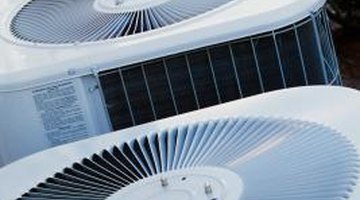What Is an Air Conditioner Accumulator?
Air conditioners contain a number of working parts. Each of these parts performs a function or functions essential to the operation of the entire air conditioning system or unit. The accumulator constitutes one such part. Simple descriptions define an accumulator as a tank. However, the actual functions of an accumulator prove more complex than such a description indicates – accumulators serve an essential task for air conditioning units and systems.
Accumulator

An accumulator is a small, cylindrical structure containing a system of pipes. An input pipe connects the accumulator to the evaporator of an air conditioning unit. An output pipe connects the accumulator to the compressor of the air conditioner. Evaporators exist as part of an air conditioner's low-pressure system, while compressors comprise part of the high-pressure system. Accumulators serve as a transition between these two systems, converting refrigerant from its low-pressure form to its high-pressure form.
Preventing Floodback
The evaporator of an air conditioning unit absorbs all of the hot air present in an environment to aid with the cooling function. Hot air mixes with liquid refrigerant in the evaporator before moving into the accumulator. Floodback occurs when liquid refrigerant enters the compressor – as part of a high-pressure system, the compressor cannot handle low-pressure materials like liquid. Accumulators prevent liquid refrigerant from damaging the high-pressure system of an air conditioner by converting it to gas. Once in gaseous form, the refrigerant moves from the accumulator to the compressor.
Absorbing Moisture
Accumulators contain something called a desiccant. A desiccant removes moisture and debris from refrigerant as it passes from its liquid to gaseous form. Debris pollutes the environment of an air conditioning unit, though moisture proves potentially more detrimental. When moisture combines with refrigerant, it forms a corrosive acid capable of destroying elements of an air conditioning unit. This turns especially dangerous in a car, if the acid leaks through an air conditioning unit and comes into contact with the engine.
Oil Removal
Accumulators remove any oil from liquid refrigerant before vaporizing the material and passing it through the high-pressure system of an air conditioner. Unlike refrigerant, oil vaporizes at an extremely slow rate, due to the complexity of its chemical make up. Because liquid oil damages a high-pressure system and vaporizing oil proves infeasible, accumulators contain mechanisms – filters, for instance – for preventing oil from entering the high-pressure system. This function applies most commonly in car air conditioners.
References
Writer Bio
Will Gish slipped into itinerancy and writing in 2005. His work can be found on various websites. He is the primary entertainment writer for "College Gentleman" magazine and contributes content to various other music and film websites. Gish has a Bachelor of Arts in art history from University of Massachusetts, Amherst.
Photo Credits
- Comstock/Comstock/Getty Images
More Articles



